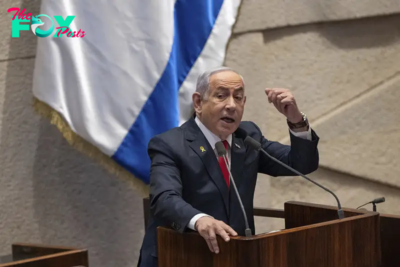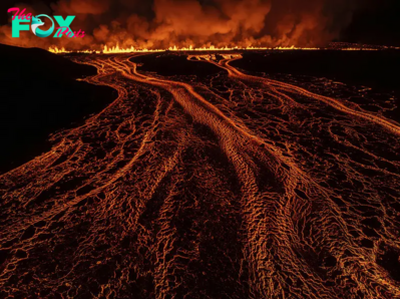World News
Hezbollah Fires Rockets at Northern Israel Amid Negotiations for Gaza Ceasefire
BEIRUT — Lebanon’s Hezbollah fired a massive barrage of rockets into northern Israel on Wednesday to avenge the killing of a top coMMAnder, further escalating regional tensions as the fate of an internationally-backed plan for a ceasefire in Gaza hung in the balance.
The retaliatory attack came as U.S. Secretary of State Antony Blinken was in the region to push a ceasefire proposal with global support that has not been fully embraced by Israel or Hamas. The militant group submitted its first official response late Tuesday, requesting “amendments” to the deal.
Hezbollah, an Iran-backed ally of Hamas, has traded fire with Israel nearly every day since the 8-month-long Israel-Hamas war began and says it will only stop if there is a truce in Gaza. That has raised fears of an even more devastating regional coNFLagration.
Air raid sirens sounded across northern Israel, and the military said that about 160 projectiles were fired from southern Lebanon, making it one of the largest attacks since the fighting began. There were no immediate reports of casualties as some were intercepted while others ignited brush fires.
Hezbollah said it fired missiles and rockets at two military bases in retaliation for the killing of Taleb Sami Abdullah, 55. Known within Hezbollah as Hajj Abu Taleb, he is the most senior commander killed since the fighting began eight months ago. The Israeli strike destroyed a house where Abdullah and three other officials were meeting, about 10 kilometers (6 miles) from the border, late Tuesday.
Israeli airstrikes on Lebanon have killed over 400 people, most of them Hezbollah members, but the dead also include more than 70 civilians and non-combatants. On the Israeli side, 15 soldiers and 10 civilians have been killed since the war in Gaza began.
Other groups allied with Iran, including powerful militias in Iraq and Syria, and the Houthi rebels in Yemen, have also attacked Israeli, U.S. and other targets since the start of the war, often drawing Western retaliation. In April, Israel and Iran traded fire directly for the first time.
U.S. President Joe Biden’s administration has said the best way to calm regional tensions is for Hamas to accept a proposal for a phased ceasefire that it says would end of the war in Gaza and bring about the release of the remaining hostages abducted in Hamas’ Oct. 7 attack that ignited the war. The U.N. Security Council voted overwhelmingly in favor of the plan on Monday.
Biden says it is an Israeli proposal, but Prime Minister Benjamin Netanyahu has sent coNFLicting signals, saying Israel remains committed to destroying Hamas. It’s unclear how it would do that if the U.S.-backed proposal, which includes an Israeli withdrawal from Gaza, is fully implemented.
Read More: For Antony Blinken, the War in Gaza Is a Test of U.S. Power
Hamas has expressed support for the broad outline of the deal but wariness over whether Israel would implement its terms, particularly provisions for an eventual permanent end to fighting and Israeli withdrawal from Gaza.
Hamas said Tuesday that it gave mediators its reply to the proposal, which appeared to be short of outright acceptance but kept negotiations alive. Qatar and Egypt, which have been key mediators alongside the United States, said mediators were studying it.
Hamas spokesman Jihad Taha said the response included “amendments that confirm the ceasefire, withdrawal, reconstruction and (prisoner) exchange.” Taha did not elaborate.
Blinken, who is on his eighth visit to the region since the start of the war, headed to Qatar on Wednesday to follow up on the negotiations.
The proposal has raised hopes of ending a coNFLict in which Israel’s bombardment and ground offensives in Gaza have killed over 37,000 Palestinians, according to Palestinian Health officials, and driven some 80% of the population of 2.3 million from their homes. Israeli restrictions and ongoing fighting have hindered efforts to bring humanitarian aid to the isolated coastal enclave, fueling widespread hunger.
Israel launched its campaign after Hamas and other militants stormed into Israel on Oct. 7, killing some 1,200 people, mostly civilians, and taking around 250 hostage. Over 100 hostages were released during a weeklong ceasefire last year in exchange for Palestinians imprisoned by Israel. Hamas is still holding around 120 hostages, a third of whom are believed to be dead.
Read More: Telling the Stories of Israel’s Hostage Nightmare
The proposal announced by Biden calls for a three-phase plan that would begin with a six-week ceasefire and the release of some hostages in exchange for Palestinian prisoners. Israeli forces would withdraw from populated areas and Palestinian civilians would be allowed to return to their homes.
Phase one also requires the safe distribution of humanitarian assistance “at scale throughout the Gaza Strip,” which Biden said would lead to 600 trucks of aid entering Gaza every day.
At the same time, negotiations would be launched over the second phase, which is to bring “a permanent end to hostilities, in exchange for the release of all other hostages still in Gaza, and a full withdrawal of Israeli forces from Gaza.”
Phase three would launch “a major multi-year reconstruction plan for Gaza and the return of the remains of any deceased hostages still in Gaza to their families.”
The militant group accepted a similar proposal last month that was rejected by Israel.
Netanyahu’s far-right coalition allies have rejected the latest proposal and have threatened to bring down his government if he ends the war leaving Hamas intact. But Netanyahu is also under mounting pressure to accept a deal to bring the hostages back. Thousands of Israelis, including families of the hostages, have demonstrated in favor of the U.S.-backed plan.
—Jeffery reported from Jerusalem.
-

 World News16h ago
World News16h agoWorld’s Best Brands – Brazil
-

 World News1d ago
World News1d agoWorld’s Best Brands – India
-

 World News1d ago
World News1d agoInternational Criminal Court Issues Arrest Warrants for Netanyahu and Hamas Commander
-

 World News2d ago
World News2d agoLandmark Bill to Ban Children From Social Media Introduced in Australia’s Parliament
-

 World News2d ago
World News2d agoAmerican and Australian Tourists Die in Laos After Drinking Tainted Alcohol
-

 World News2d ago
World News2d agoSee Photos of the Seventh Volcanic Eruption on Iceland’s Reykjanes Peninsula in 12 Months
-

 World News2d ago
World News2d agoMuhammad Yunus on the Race to Build Bangladesh 2.0
-

 World News2d ago
World News2d agoU.S. Charges Indian Billionaire Gautam Adani With Defrauding Investors



















